| Author | Affiliation |
|---|---|
| Mark I. Langdorf, MD, MHPE | University of California, Irvine School of Medicine, Department of Emergency Medicine, Orange, CA |
| Francesco Della Corte, MD | University of Eastern Piedmont School of Medicine, Department of Anesthesia, Critical Care and Critical Emergency Medicine, Novara, Italy |
| Roberta Petrino, MD | St. Andrea Hospital, Department of Emergency Medicine, Vercelli, Italy |
This issue of the Western Journal of Emergency Medicine (WestJEM) is devoted to the dissemination of international research and education in emergency medicine (EM). As the specialty gains recognition across the globe, the sharing of ideas from East to West, North to South becomes not only more feasible, but more important. One of the reasons for the name, “Western Journal of Emergency Medicine” was to provide an English language outlet to the Western hemisphere for Eastern hemisphere research. Over the past three years, we have increasingly received submissions from international authors. To recognize this expanded scope, we have chosen to cluster our international papers into a single issue.
Figure 1 shows the number of nations where EM has become a recognized medical specialty from 1970 to 2008. Similarly, in Europe EM is growing rapidly. The European Society of EM (EuSEM) held its 10th annual meeting and currently includes 25 European national societies of EM, representing more than 20,000 emergency physicians. Figure 2 shows the status of specialty recognition for the European continent.
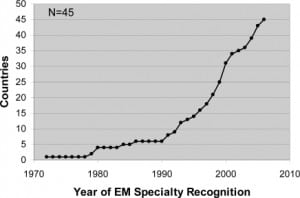
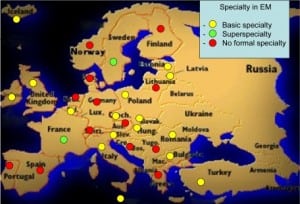
The objectives of EuSEM are to ensure the highest quality emergency care for patients, delivered by physicians trained in EM. Furthermore, EM should be developed as a primary medical specialty in all European countries and foster the organization of comparable training programs across Europe.1
On the educational front, the Task Force for European Training Curriculum in EM was established in 2007 to include delegates from 17 national societies, and was chaired by Dr. Roberta Petrino, director of the ED in Vercelli, Italy.2 The curriculum was approved by the UEMS in October 2009, and now forms the basis for EM education across Europe.
The European Masters in Disaster Medicine is another substantial marker of EM’s reach across the world. Figure 3 shows where students for this two-year master degree have come from within Europe, and Figure 4 shows their distribution across the globe.
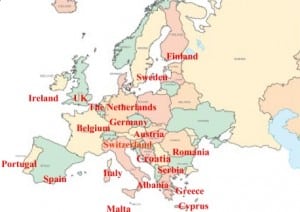
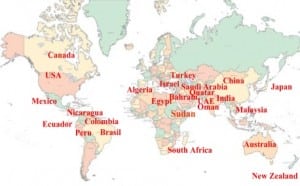
Among the potential leadership roles identified for international EM organizations, Arnold and Della Corte included the following initiatives:3
-
Identification and promotion of clinical policies and practices that benefit emergency patients.
-
Fulfillment of moral imperative to advocate for and promote global equity in emergency care systems, particularly those serving world’s most vulnerable populations, including its poorest countries and communities.
-
Development of international ethical and clinical norms and standards in EM.
-
Organization of conferences, symposia, teaching programs.
-
Use of open website.
-
Encouraging submission of publication in peer-reviewed journals.
WestJEM contributes to several of these, through dissemination of curricula for international EM (see Koenig, Bey, Schultz in this issue), practice guidelines, the journal’s open-access electronic format, which is freely available to the world’s poorest areas, and, of course, through the publication of worldwide research.
The five biannual Mediterranean EM Congresses are another marker of the specialty’s growth around the world. Figure 5 shows the number of delegates and the countries represented.
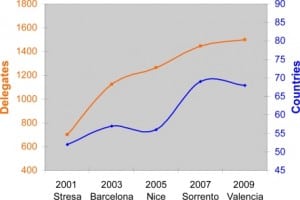
Truly EM has become a global specialty, but much work remains. We at WestJEM seek to foster free dissemination of ideas, research, educational advances and intellectual discourse. Thank you for your support of this vital initiative.
Footnotes
Submission history: Submitted October 1, 2009; Accepted October 14, 2009
Full text available through open access at http://escholarship.org/uc/uciem_westjem
Address for Correspondence: Mark I. Langdorf, MD, MHPE, Department of Emergency Medicine, 101 The City Drive, Rte 128-01 Orange, CA 92868.
Email: milangdo@uci.edu
Conflicts of Interest: By the WestJEM article submission agreement, all authors are required to disclose all affiliations, funding sources, and financial or management relationships that could be perceived as potential sources of bias. The authors disclosed none.
REFERENCES
1. European Society for Emergency Medicine Policy Statement on Emergency Medicine in EuropeSeptember2007. Available at:http://www.eusem.org/Pages/About_EuSEM/Policy_Statements/Policy_Statements.html Accessed November 1, 2009.
2. UEMS Multidisciplinary Joint Committee on Emergency Medicine, European Society for Emergency Medicine European Curriculum for Emergency Medicine April252009; Brussels, Belgium. Available at:http://www.eusem.org/assets/PDFs/Curriculums/European_Curriculum_for_EM-Aug09-DJW.pdfAccessed November 1, 2009.
3. Arnold J, Della Corte F. International Emergency Medicine: Recent Trends and Future Challenges.Eur J Emerg Med. 2003;10:180–8. [PubMed]


